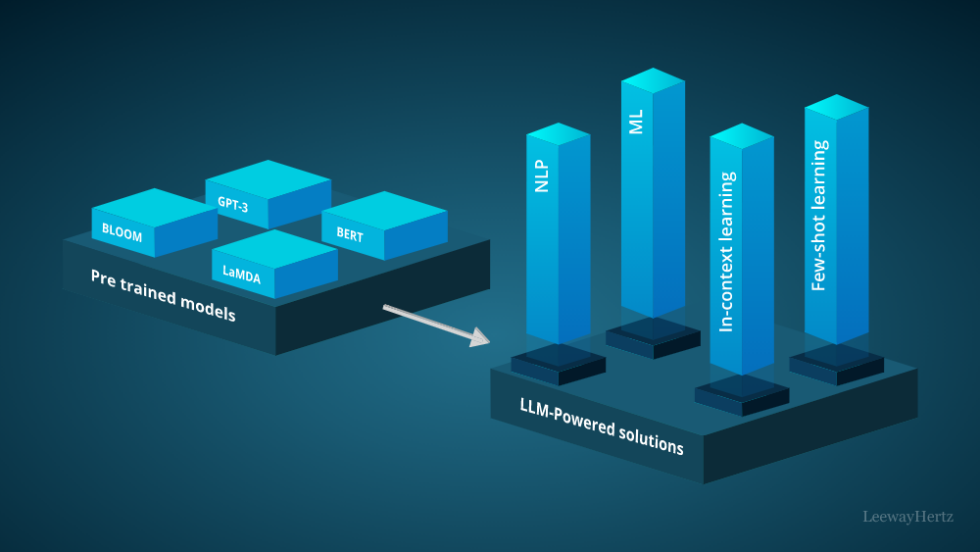The Rise of Large Language Models: Transforming Text Based Content Generation and Information Processing

Large Language Models (LLMs) are driving a paradigm shift in text-based content generation and information processing. With their ability to understand, generate, and analyze human language, LLMs are transforming how businesses and individuals communicate and extract insights from vast amounts of textual data. In this blog, we will explore the pivotal role of an LLM model development company and AI development services in harnessing the potential of LLMs. Additionally, we will delve into the process of building an LLM model, unlocking the power of this transformative technology.
The impact of LLMs in communication and information processing
LLMs have become instrumental in reshaping text-based content generation and enhancing information processing capabilities. Here are some key areas where LLMs have made a significant impact:
- Natural language understanding: LLMs excel in comprehending and interpreting human language, enabling more effective communication between machines and humans. They can understand user queries, analyze sentiment, and extract meaning, leading to improved user experiences and more personalized interactions.
- Text generation: LLMs can generate coherent and contextually relevant text, making them valuable in content creation, chatbots, and virtual assistants. They automate content production, respond to user inquiries, and facilitate engaging conversations, revolutionizing how businesses communicate with their audiences.
- Information retrieval: LLMs enhance information retrieval systems by understanding the context and semantics of user queries, leading to more accurate and relevant search results. They analyze vast amounts of textual data, extract key insights, and enable efficient knowledge discovery, aiding decision-making processes.
- Language translation: LLMs can perform accurate machine translation of text from one language to another. LLMs foster seamless communication across different languages by capturing nuances and context, facilitating global collaboration and understanding.
- Sentiment analysis: LLMs assist in sentiment analysis, identifying the sentiment that is being expressed in a text, such as positive, negative, or neutral. By understanding text sentiment, LLMs contribute to sentiment analysis applications like social media monitoring, customer feedback analysis, and brand reputation management.
The role of LLM model development companies
LLM model development companies play a vital role in harnessing the power of this transformative technology. They offer specialized expertise in developing LLMs and provide AI development services, including:
- LLM model development: These companies excel in building customized LLMs tailored to specific business needs. They leverage cutting-edge techniques, deep learning frameworks, and extensive datasets to train and optimize LLMs for various applications.
- Fine-tuning and customization: LLM development companies offer fine-tuning and customization services to adapt pre-trained models to specific tasks and domains. This ensures that the LLMs meet the unique requirements of businesses, resulting in improved performance and accuracy.
- Integration and deployment: LLM development companies assist businesses in seamlessly integrating LLMs into existing systems and platforms. They support deployment, scalability, and optimization, ensuring efficient utilization of LLM capabilities.
- Consulting and strategy: LLM development companies offer consulting services to guide businesses in harnessing the power of LLMs effectively. They provide strategic advice on implementing LLMs, identifying use cases, and optimizing workflows to maximize the benefits of this technology.
How to build an LLM model?
Building a large language model (LLM) requires expertise in natural language processing (NLP), deep learning, and access to large-scale datasets. The general steps for building an LLM model are as follows:
- Define the scope and objectives: Determine the purpose of your LLM model and define the specific tasks or applications it will be designed for. This could range from text generation to question answering or language translation.
- Gather and preprocess training data: Collect a diverse and representative dataset for training the LLM model. This dataset should align with the objectives of your model. Preprocess the data by cleaning, normalizing, and tokenizing the text, removing irrelevant or noisy information, and ensuring proper formatting.
- Architecture selection: Choose an appropriate deep-learning architecture for your LLM model. Recurrent Neural Networks (RNNs) with Long Short-Term Memory (LSTM) or Gated Recurrent Units (GRUs) are commonly used for language modeling tasks. Transformer-based architectures, such as the popular GPT (Generative Pre-trained Transformer) models, have also shown excellent performance in language generation tasks.
- Training: Train the LLM model using the preprocessed dataset. This typically involves optimizing the model’s parameters to minimize the loss function, such as cross-entropy loss, through techniques like backpropagation and gradient descent. Training a large language model often requires substantial computational resources, including powerful GPUs or TPUs and distributed training techniques.
- Fine-tuning: If you have a specific task or domain in mind, you may fine-tune the pre-trained LLM model on a smaller task-specific dataset. This process adapts the model to suit the specific requirements of your application better.
- Evaluation and validation: Assess the performance of the trained LLM model using appropriate evaluation metrics. This can involve measuring perplexity, BLEU scores, accuracy, or other task-specific metrics. Validate the model’s outputs through human evaluation or real-world testing scenarios to ensure the desired quality and reliability.
- Iterative refinement: Iterate and refine the LLM model based on the evaluation results and user feedback. This may involve adjusting hyperparameters, improving the training pipeline, or incorporating new techniques and advancements in NLP research.
Conclusion
As LLM technology continues to advance, we can expect further transformative applications and new opportunities across industries. From improving customer interactions to automating content creation and streamlining information retrieval, LLMs are redefining text-based content generation and information processing. Whether it’s understanding user queries, generating human-like text, or enhancing language translation, LLMs are reshaping the communication landscape. Businesses that partner with LLM model development companies and leverage AI development services can unlock the full potential of LLMs to gain a competitive edge, enhance customer experiences, and derive valuable insights from textual data. As LLMs continue to evolve, their impact will only grow, opening up new horizons for text-based content generation, information processing, and AI-driven systems.






